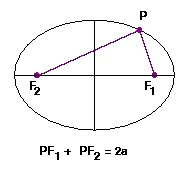Instructions:Answer all the following questions in the space provided. Simplify all answers.
- What effect does the xy term have on the general conic sections?
The xy term can have a rotational effect on the general conic sections.
- What is the locus definition of an ellipse? Define the terms used in the definition. You may use a diagram to help explain.
| An ellipse is a locus of points such that the sum of the distances from any point P on the ellipse, to two fixed points (F1 and F2) is constant. That is PF1 + PF2 = constant. These two fixed points are called focal points and they are the only points that make the above statement true. |
 |
- Given the following ellipses, find their focal points.
|
| (Ö5, 0) and (-Ö5, 0) |
|
|
|
|
| (0, 3) and (0, -3)
|
| |
|
| c) | (x + 1)2
36 | + | (y - 4)2
11 | = 1 |
| (4, 4) and (-6, 4)
|
| |
|
| d) | (x - 2)2
16 | + | (y + 3)2
36 | = 1 |
| (2, (Ö20) - 3) and (2, -(Ö20) - 3)
| | |
- For the following pairs of focal points, find the standard equation of each ellipse.
a) (-2, 0) and (2, 0) and 2a = 6
|
b) (0, 3) and (0, -3) and 2b = 10
|
c) (1, 1) and (-1, 1) ans 2a = 4
|
- What is the locus definition of a hyperbola? Define the terms used in the definition. (You may use a diagram to help explain.)
A hyperbola is a locus of points such that the difference of the distances from any point P on the hyperbola, to two fixed points (F1 and F2) is constant. That is PF1 - PF2 = constant. These two fixed points are called focal points and they are the only points that make the above statement true.
- Given the following hyperbolas, find their foci and vertices.
|
|
focal points: (-10, 0) and (10, 0)
vertices: (-5, 0) and (5, 0) |
|
focal points: (-4, 0) and (4, 0)
vertices: (-3, 0) and (3, 0) |
|
focal points: (0, -Ö34) and (0, Ö34)
vertices: (0, -5) and (0, 5) |
- For the following pairs of focal points and vertices, find the standard equation of each hyperbola.
| a) | foci: (3, 0) and (-3, 0) |
| vertices: (1, 0) and (-1, 0) |
|
| b) | foci: (0, 5) and (0, -5) |
| vertices: (0, 2) and (0, -2) |
|
| c) | foci: (6, 0) and (-6, 0) |
| vertices: (2, 0) and (-2, 0) |
|
| | |
- What is the locus definition of a parabola? Define the terms used in the definition. (You may use a diagram to help explain.)
A parabola is the locus of all points whose perpendicular distance from a fixed line (the directrix) is equal to the distance from a fixed point (the focal point).
The focal point is the special fixed point through which all rays travelling toward the parabola and parallel to the axis of symmetry are reflected. The directrix is a specific fixed line which makes the above definition true.
- Given the equation of each parabola, state the vertex and find the focal point and the equation of the directrix.
a) y = x2 + 2x + 1
vertex: (-1, 0)
focal point: (-1, 1/4)
directrix: y = -1/4
b) y2 - 8x + 2y + 17 = 0
vertex: (2, -1)
focal point: (4, -1)
directrix: x = 0
c) 2y2 + 8y - 16x = 8
vertex: (-1, -2)
focal point: (1, -2)
directrix: x = -3
d) 2x2 - 5x - y + 4 = 0
vertex: (5/4, 7/8)
focal point: (5/4, 1)
directrix: y = 3/4
- Given the following focal points, vertices and directrixes, find the standard equation of each parabola.
| a) | focus: (0, 0) |
| vertex: (0, -2) |
| directrix: y = -4 |
| |
| b) | focus: (2, 3) |
| vertex: (5, 3) |
| directrix: x = 8 |
|
|
|
